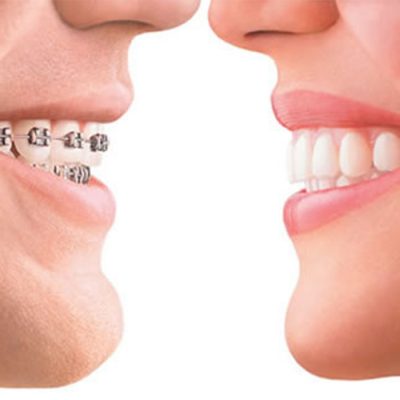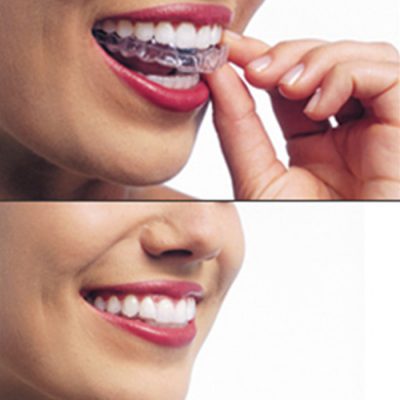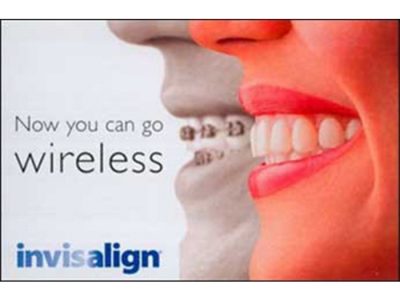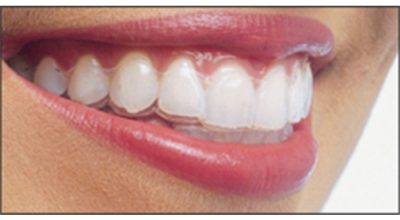
Is it possible to straighten your teeth with out ugly braces brackets?
This is the most common question asked by patients who want to straighten their teeth but are reluctant to do so because of the visibility of conventional braces. Recently, with advancements in 3 D imaging technology and the introduction of invisalign, the possibility of straightening your teeth without braces has become a dream come true for many patients.

What is invisalign?
Instead of using traditional metal or ceramic dental braces, Invisalign uses a revolutionary method of orthodontic teeth movement. A series of clear, removable teeth aligners are used instead. See picture on the left. Invisalign is designed, manufactured, and marketed by a Santa Clara based medical-device company Align Technology, Inc.
Every 2 weeks, a new aligner will be custom made to fit you exactly. This bespoke invisalign aligner will move your teeth incrementally week by week. A series of aligners will be given to you to wear until the final desired tooth position is achieved.

What is Clinckeck Treatment Planning?
This is a 3D invisalign treatment planning. This advanced 3D program will show the series of teeth movement that will occur when you wear the aligners. As a result, you can have a preview of how your teeth will look like when the treatment is completed. From the results of the ClinCheck treatment plan, your custom-made invisalign aligners are generated to fit you only.


Why should I use invisalign instead of traditional braces?
1)The invisalign aligners are completely transparent, therefore they are practically invisible as compared to traditional metal or ceramic braces. For this reason, invisalign has a large following among adults who want to straighten their teeth without the look of traditional metal braces.
2) The invisalign aligners are more comfortable than traditional braces. Ulcers of the mouth due to irritating brackets and ligature wires are a thing of the past when invisalign is used.
3)Invisalign results in better oral maintenance. As the aligners are removable during eating, there will be no food trapped as opposed to traditional braces. Oral hygiene maintenance is generally much better for patients wearing invisalign as they are removable for proper tooth brushing and flossing. As a result, gum diseases and tooth decay are greatly reduced during the orthodontic treatment period
4) Invisalign orthodontic treatment is more comfortable with less pain and discomfort. Traditional braces are tightened every 6 weeks, therefore more orthodontic force is required. On the other hand, patients on invisalign change to a new set of aligners approximately every two to three weeks. Therefore the invisalign aligners require less force per week and as a result they are more comfortable with less pain than traditional braces.
5) There is no food restriction for invisalign wearers. This is because the invisalign aligners can be removed during meal times. Patients with traditional braces on the other hand have to be careful with the type of food that they eat as hard chewing on foods can result in brackets or wires dislodgement and also damage to orthodontic appliances.
What are the disadvantages of invisalign?
1)By virtue of the fact that they are removable, the effectiveness of invisalign is largely dependent on a patient’s habits and cooperation. The success of the Invisalign aligners is largely dependant on a patient’s cooperation to wear the aligners for at least 20 hours per day, preferably only removing them when they are eating, or for oral hygiene procedures.
2) Invisalign is definitely more expensive than traditional wire and bracket systems.
3) Invisalign treatment is not suitable for teeth that require vertical movement. The invisalign aligners work well by applying pressure on teeth, which means that the aligners are effective for moving teeth sideways. Teeth that are too low or too high in the gums require pulling orthodontic forces to move the teeth into place. In this respect, conventional braces are better.
4) Invisalign aligners may fail to rotate some teeth especially if the tooth is rounded in shape. Rounded tooth for example some lower premolars and upper lateral incisors may not be effectively rotated as it is difficult for the aligners to grasp and apply a rotational force to them
5) If the patient does not wear the invisalign aligners for the specified duration, the teeth will not move to the prescibed position. When the patient present themselves for the next set of aligners, the next aligner in the series will not fit. The orthodontist must then take a new set of molds of the teeth to make a new set of aligners, resulting in increased costs for invisalign orthodontic treatment.
